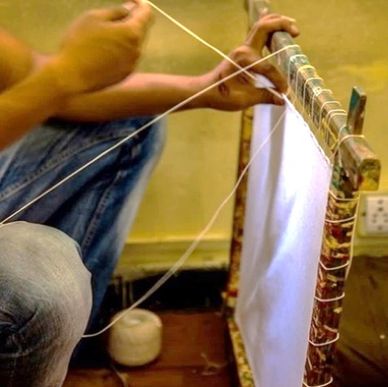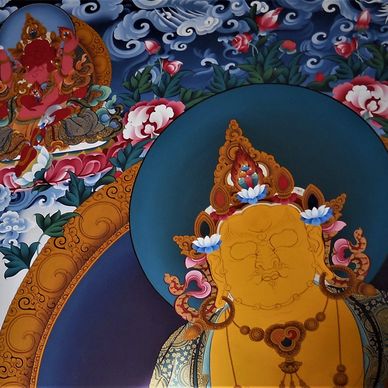Highest Quality Thangka Art has been our Family Tradition since Generations
How are our Thangkas painted?
Canvas Preparation
Shading and Coloring
Canvas Preparation

- Take a piece of cotton as per need and stitch all four sides leaving holes on four corners so that the string can be passed through.
- Strung the sewed cloth tightly on a wooden frame (or metal frame) by adjusting the string on each corner followed by a stitch of a strong string which holds each side of cloth with each side of the frame.
- Prepare a mixture of water, white clay, and glue in a pot. The mixture should be medium; not too runny or too thick. Then, apply the mixture on both surfaces of the cloth and leave it to dry.
- When completely dried, one of the sections (generally vertically which the canvas is not too big) is moistened by rubbing with a piece of wet cotton followed by a gentle but repeated rub with a smooth stone. Once the whole surface is done then the canvas is left to dry. Then the same process is repeated on another surface. This step is continued until the desired smoothness is not achieved. Smooth surface is the must for further process of painting a thangka.
Sketch
Shading and Coloring
Canvas Preparation

In general, Thangka painting starts with landscape i.e., shading sky, land, cloud, flowers, leaves, rocks etc. where shading shows the gradation of the color applied. Then, rest part of the thangka is painted with the appropriate color. Traditionally, extraction from plants and minerals were used as natural color. However, these days there is a high tendency of using easily available paints in the market.
Shading and Coloring
Shading and Coloring
Che and Marche(Outlining)

In general, Thangka painting starts with landscape i.e., shading sky, land, cloud, flowers, leaves, rocks etc. where shading shows the gradation of the color applied. Then, rest part of the thangka is painted with the appropriate color. Traditionally, extraction from plants and minerals were used as natural color. However, these days there is a high tendency of using easily available paints in the market.
Che and Marche(Outlining)
Che and Marche(Outlining)
Che and Marche(Outlining)

After completion of coloring and shading, the outlines and minute details are drawn in the central figure(mostly the robe, ornaments, and objects keeping face and body for later) as well as the surroundings of the paintings.
Gold Painting
Che and Marche(Outlining)
Face and Body Painting

In Thanka/Thangka pure gold (extracted from 24-carat gold) dust is used and the amount vary depending on the size and type of the thangkas. Generally, gold is applied on the robe of the deity, shrine, ornaments, and objects being carried. However, gold can be found on the leaves, rocks as well. If the thangka is supposed to be painted full of gold, then the background of the thangka is painted with gold (thin layer), and then and only the sketching, coloring, outlining, and other steps begins. In addition to extraction of 24 carat, other types of gold are also available in the market.
Face and Body Painting
Che and Marche(Outlining)
Face and Body Painting

This process is nearly an end-stage of painting process. The work-related in giving proper body shape of the deity is called Kumje which is followed by Kumje (facial section). The shading of the body part starts after Kumje and Chenge which is called Syamtang.
After all the major works final review is done to assure that the painting is correct in all aspects.
Gold Polishing
Silk Brocade Molding(optional)
Silk Brocade Molding(optional)

In this step, generally, all the gold being painted in the thangka is carefully polished with the help of pointed shi (a type of smooth stone found in the Himalaya) of various sizes. This step can be omitted as per need.
Silk Brocade Molding(optional)
Silk Brocade Molding(optional)
Silk Brocade Molding(optional)

Traditionally, thangkas are molded in the silk frame so that they can be hung as per need. Such thangkas can be rolled up easily and are convenient for traveling with also. However, the thangkas can be also framed in glass framed.